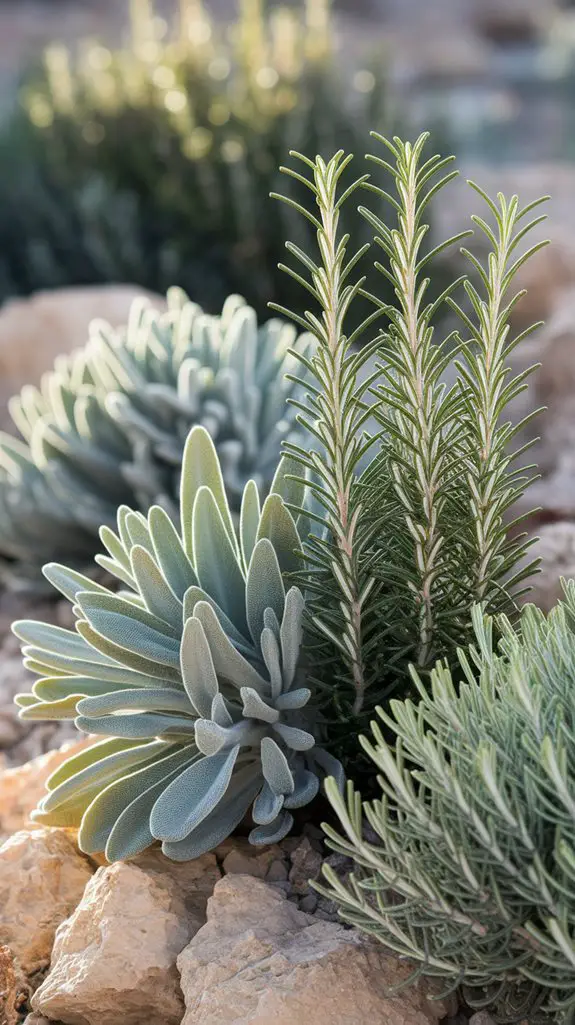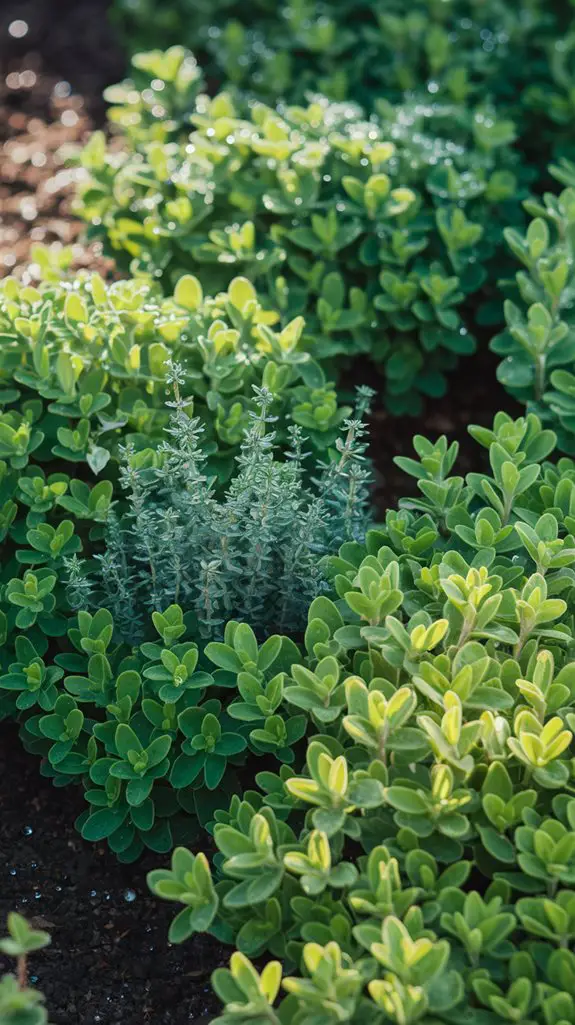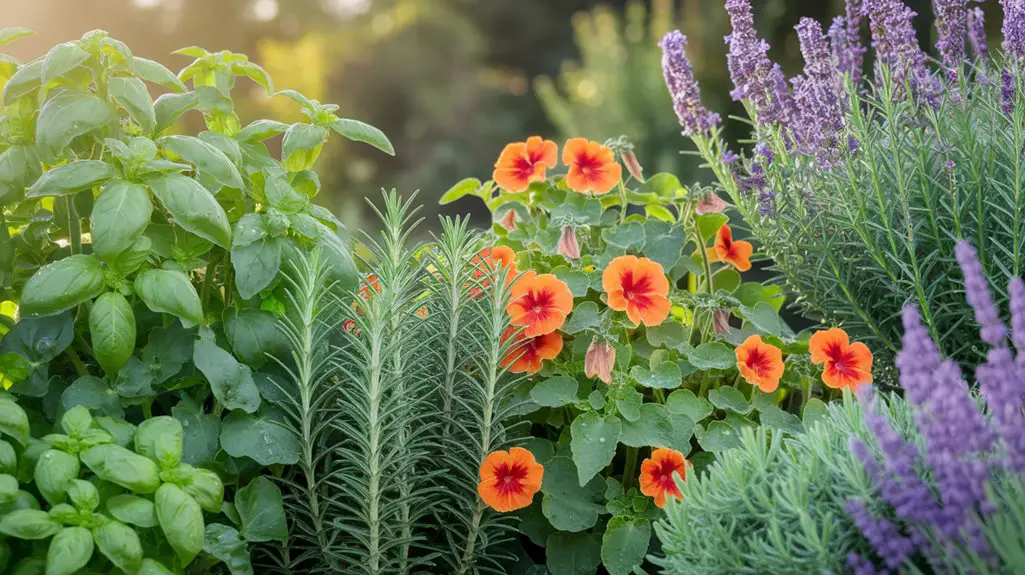You've probably noticed that some plants in your garden simply grow better together than others. This isn't coincidence—it's companion planting at work. When you pair compatible herbs strategically, you'll enjoy enhanced flavors, natural pest protection, and more vigorous growth with minimal effort. The right combinations can transform your herb garden from merely functional to exceptionally productive. What exactly makes certain herbs such perfect partners?
Basil and Tomato: A Classic Mediterranean Partnership
When planning your herb garden, few combinations are as celebrated or effective as basil and tomato. These Mediterranean natives share similar growing requirements, thriving in full sun and well-drained soil with moderate watering.
Beyond practical compatibility, they offer mutual benefits. Basil repels tomato hornworms, whiteflies, and mosquitoes, acting as a natural pest deterrent. It's also believed to enhance tomato flavor and vigor through biochemical interactions. Additionally, both plants can flourish in a raised bed herb garden, maximizing space and light exposure.
For ideal results, plant basil 10-12 inches from tomato plants, allowing sufficient space for both to mature. You'll find this pairing works in traditional gardens, raised beds, and even containers on balconies or patios.
Harvest basil regularly to promote bushier growth and prevent flowering, ensuring continuous protection for your tomatoes throughout the growing season.
Rosemary and Sage: Drought-Tolerant Defenders

Moving from Mediterranean annuals to Mediterranean perennials, rosemary and sage form another powerful partnership in the herb garden.
These woody herbs share similar growing requirements—both thrive in full sun, well-drained soil, and can withstand extended dry periods.
When planted together, they create a protective zone that deters numerous pests. Rosemary's pine-like oils repel cabbage moths and carrot flies, while sage wards off cabbage loopers and flea beetles.
You'll find their strong aromatic qualities also confuse many pest insects searching for host plants. Additionally, this duo exemplifies companion planting techniques that enhance garden health and biodiversity.
Beyond pest management, this pairing offers year-round structure to your garden with complementary growth habits.
Rosemary's upright or cascading forms contrast beautifully with sage's broader, textured foliage. Their silver-green coloration creates a cohesive aesthetic that remains attractive even in winter dormancy.
Mint and Cabbage: Pest Management Duo

Contrary to what many gardeners assume, mint and cabbage form a surprisingly effective pest management partnership in the herb garden. The aromatic oils in mint repel cabbage moths, flea beetles, and aphids that typically plague cabbage plants, while cabbage provides ground cover that prevents mint's aggressive rhizomes from spreading unchecked.
You'll gain multiple benefits from this strategic pairing:
- Reduced pest pressure – mint's strong scent confuses and deters cabbage pests without chemical interventions.
- Natural growth control – cabbage's dense leaf structure helps contain mint's invasive tendencies.
- Companion harvest cycles – cabbage matures while mint establishes, providing continuous garden productivity.
For best results, plant mint at cabbage perimeters rather than intermixing directly. This spacing allows mint's volatile compounds to circulate without competition for nutrients. Additionally, utilizing DIY traps for common pests can enhance your pest management strategy even further.
Dill and Cucumbers: Pollinator-Attracting Team

The pairing of dill and cucumbers creates one of the most symbiotic relationships in the herb garden, particularly due to their complementary roles in pollinator attraction.
When you plant dill near cucumbers, its delicate yellow flowers become powerful magnets for beneficial insects like honeybees, syrphid flies, and parasitic wasps. These pollinators don't just visit the dill—they'll also service your cucumber flowers, markedly increasing fruit set and yield.
The tall, airy structure of dill provides vertical interest while creating partial shade that moderates soil temperature for cucumber roots. As an added bonus, dill's strong aroma helps deter cucumber beetles and aphids that typically plague cucumber plants.
For best results, sow dill seeds every few weeks throughout the growing season to guarantee continuous flowering and maximum pollinator presence.
Oregano and Thyme: Low-Growing Ground Cover Companions

While dill and cucumbers create vertical diversity in your garden, oregano and thyme form a perfect partnership at ground level.
These Mediterranean herbs thrive in similar growing conditions—full sun and well-drained soil—making them natural companions. When planted together, they create a dense, aromatic carpet that effectively suppresses weeds while maximizing your growing space.
These low-growing herbs offer three key benefits:
- Pest deterrence – Their strong essential oils naturally repel many common garden pests including cabbage moths and aphids.
- Soil protection – Their spreading habit reduces soil erosion and moisture evaporation during hot summer months.
- Extended harvest – With proper trimming, you'll enjoy continuous harvests from spring through fall.
Additionally, planting these herbs can attract beneficial insects that contribute to a healthier ecosystem in your garden.
Plant these herbs along pathway edges or between taller plants to utilize otherwise empty spaces in your garden.
Chives and Carrots: Root-Enhancing Neighbors
Planting chives alongside carrots creates one of the most beneficial partnerships in the herb garden, as the pungent allium family member actively improves both the growth and flavor of your root vegetables.
The strong scent of chives repels carrot rust flies and other pests that typically damage carrot crops, providing natural protection without chemicals.
You'll find that chives' shallow root system also complements carrots' deeper growth habit, allowing them to share space efficiently without competing for nutrients.
When harvesting, you'll notice sweeter carrots with more vibrant color.
For best results, plant chives at the corners and edges of your carrot beds, creating a protective barrier that maximizes your growing space while maintaining this beneficial relationship year after year.
Cilantro and Spinach: Shade-Loving Combinations
Moving from root vegetables to leafy companions, cilantro and spinach form an ideal pairing for gardeners seeking to maximize yield in partially shaded areas.
Both herbs thrive in cooler conditions and benefit from protection against harsh afternoon sun. Plant cilantro slightly north of your spinach to create a natural canopy without competing for nutrients.
You'll experience three distinct advantages with this combination:
- Natural pest deterrence – cilantro's strong scent repels aphids and spider mites that typically attack spinach
- Extended harvest window – spinach moderates soil temperature, preventing cilantro from bolting prematurely
- Nutrient optimization – cilantro's shallow roots don't compete with spinach's deeper system
Water this pairing consistently at soil level to prevent fungal issues.
Harvest outer leaves first to encourage continuous production throughout the growing season.
Conclusion
By implementing these companion planting strategies, you'll create a more resilient and productive herb garden. Research shows that tomato plants grown with basil companions produce up to 20% higher yields than those grown alone, demonstrating the tangible benefits beyond pest management. Don't overlook these natural synergies—they're your most sustainable tool for maximizing harvest quality while minimizing chemical interventions in your garden ecosystem.




